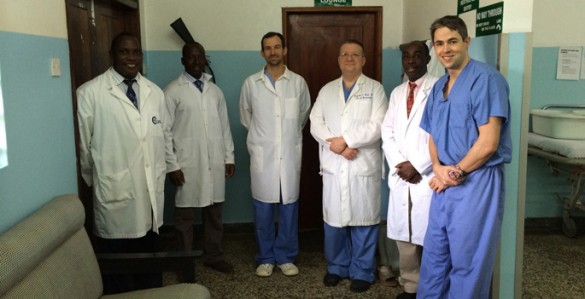
Rob Naftel, M.D., traveled more than 8,000 miles to learn a new surgical technique to treat hydrocephalus, the buildup of cerebrospinal fluid in the brain.
At a CURE Children’s Hospital in Mbale, Uganda, Naftel trained under Ben Warf, M.D., who pioneered the combination of two surgical treatments there a decade ago. Naftel brings those techniques to the Monroe Carell Jr. Children’s Hospital at Vanderbilt in preparation for a study to evaluate the long-term outcomes of the treatment.
Most children with hydrocephalus are implanted with a shunt, a tube that drains excess spinal fluid from the head into the belly.
Without the drain, the fluid buildup can affect brain development and cause disability or death.
“Shunts are great, but it’s like the plumbing in your house. Eventually those pipes are going to clog up. For a lot of children in places like Uganda, without immediate access to medical care, shunts aren’t the best option,” Naftel said.
Another procedure, called endoscopic third ventriculostomy (ETV), reroutes the brain’s plumbing without any foreign hardware, but isn’t always successful, especially in children younger than 2.
Warf combined ETV with a procedure called choroid plexus cauterization, which destroys the tissue that makes cerebrospinal fluid.
He followed the children post-operatively and found high success rates for the surgery.
“Children younger than 1 have a 50 percent chance of needing another shunt operation within a year. We think that patients chosen correctly for this combined operation have somewhere between a 50-75 percent chance of not needing a shunt ever,” Naftel said.
Warf, now director of the Neonatal and Congenital Anomaly Neurosurgery at Boston Children’s Hospital, was named a MacArthur Foundation Fellow in 2012, a so-called “genius grant.”
Naftel, who joined the Children’s Hospital faculty in August, has trained under Warf in anticipation of a multi-site outcomes research study, led by the Hydrocephalus Clinical Research Network (HCRN), which Vanderbilt joined in 2013.
“Dr. Naftel brings a phenomenal skill set in several major areas, including the surgical management of pediatric epilepsy, spasticity and spine,” said Jay Wellons, M.D., MSPH, chief of Pediatric Neurosurgery at Children’s Hospital.
“But it’s his career-long interest in complex neuro-endoscopic surgery that afforded him this opportunity. His time with Ben is just invaluable as we work regionally and with the HCRN to improve the care and long-term outcomes of children with hydrocephalus.”
Naftel said the research will help physicians understand the longevity of this treatment.
“There is much that we still do not know about this therapy and how it compares to shunting. This is why it is so important for us to study the outcomes of our patients closely to ensure that we are meeting their needs,” he said.
Naftel said being able to care for children in Uganda was a bonus of the training.
“It was amazing to travel to ground zero of this new and potentially revolutionary treatment for hydrocephalus and to learn directly from the person who pioneered this treatment.”












